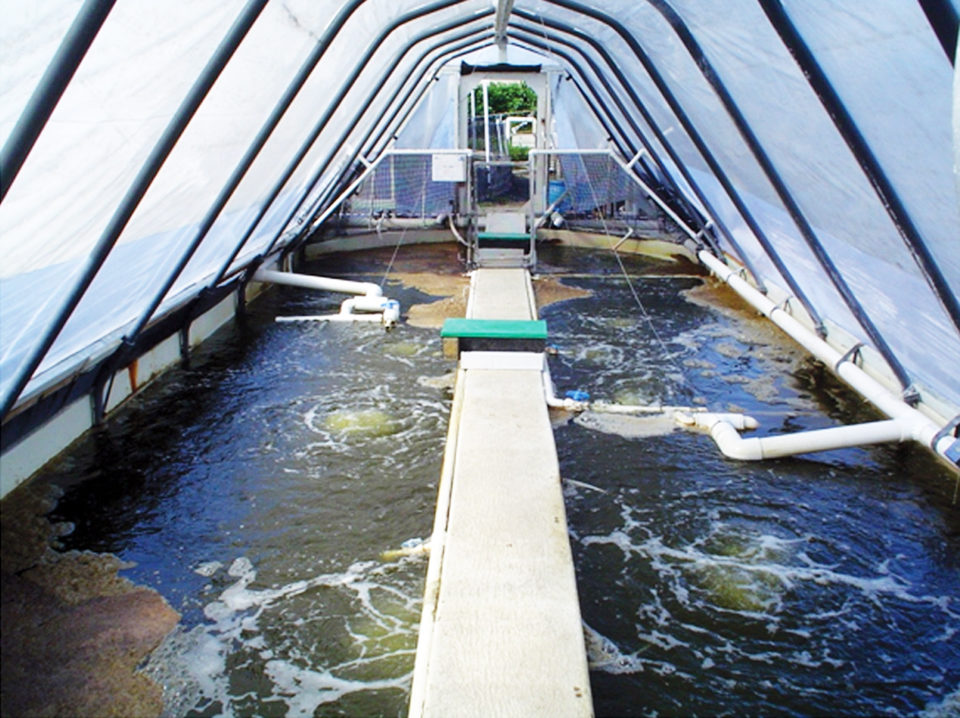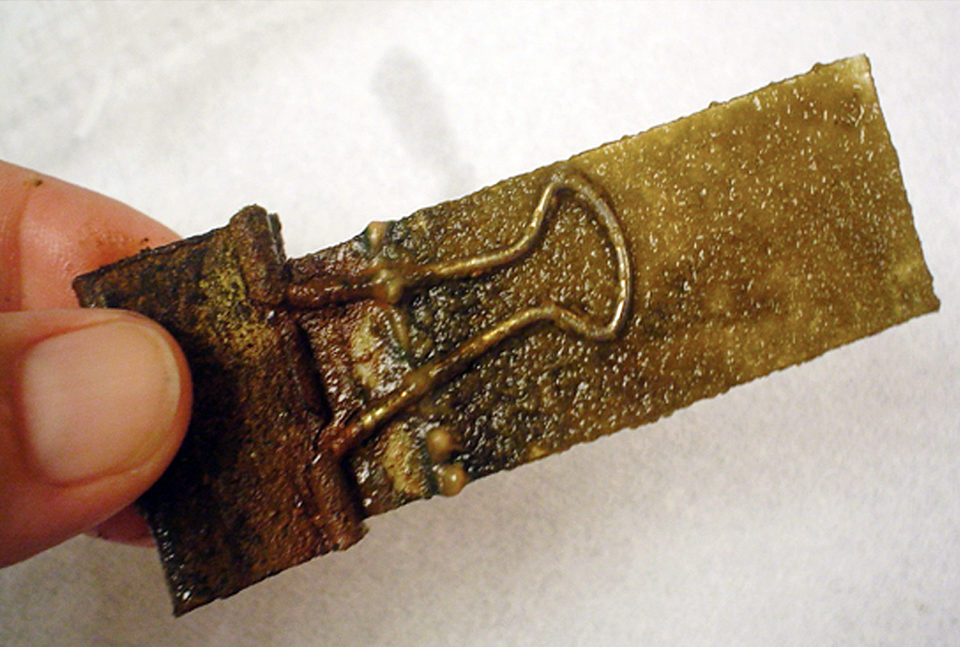Genetic diversity and elevated rates of nitrification illustrate the critical importance of biofilms

The use of recirculating aquaculture systems (RAS) for shrimp represents a major paradigm shift from current methods that rely on open, coastal ponds and flow-through water exchange to maintain water quality. RAS rely on the biogeochemical capabilities of the in situ microbial community to provide acceptable water quality for the target species.
In super-intensive RAS where little to no water is exchanged, nitrification and uptake of dissolved inorganic nitrogen (DIN) by phytoplankton are critical for the detoxification and removal of ammonia and nitrite. However, interrelationships among various functional groups within the microbial community are complex and poorly understood.
Because of this complexity, optimal microbial community nitrogen cycle functions have not been well characterized for RAS. Critical control variables that promote high rates of ammonium oxidation, nitrite oxidation and phytoplankton DIN have yet to be elucidated for super-intensive aquaculture. A clear understanding of these control variables and their implementation in RAS management strategies will be highly effective in promoting shrimp growth and survival under environmentally sound conditions.
Oceanic Institute study
With the support of the U.S. Marine Shrimp Farming Program and the Hawaii Pacific University Trustees Scholarly Endeavors Program, scientists at the Oceanic Institute have measured ammonia removal and oxidation rates in water column samples over the course of several shrimp production trials in super-intensive RAS.
Results indicated that the ammonia oxidation in water column samples ranged from 0.92 to 2.60 µmole/L/hour for a mean of 1.7 ± 3.4 µmole/L/hour. This rate exhibited little variation after the initial acclimation period.
However, nitrogen budget analysis based on the production and accumulation of nitrate, the end product of nitrification, suggested that ammonia oxidation in the water column at these rates cannot account for the accumulation of nitrate over time. Therefore, nitrification must be occurring in locations other than on water column particles. Nitrifying bacteria readily form biofilms on surfaces, and colonization by these important bacteria on the interior walls of the RAS production unit likely provided an additional source of nitrification.
To investigate this, the authors submerged microscope slides in the RAS water column to allow the formation of biofilms. The time points encompassed the initial acclimation period as well as after ammonia and nitrite concentrations became stable. Because full nitrification of ammonia to nitrate is critical to RAS water quality, these time points allowed researchers to ascertain the arrival and proximity of ammonia and nitrite oxidizers to each other in space and time.
These filmed slides were subsequently exposed to 15N-ammonia or 15N-nitrite during three-hour incubations. Changes in the concentration of ammonia, nitrite and nitrate were measured, and uptake of the 15N label into the biofilm itself was measured to quantify phytoplankton and heterotrophic uptake. The authors also conducted fluorescent in situ hybridization (FISH) assays and extracted DNA from the biofilm samples to determine key groups of nitrifying organisms and relate them to the measured nitrification rates.

Results
Interestingly, the first incubation on day 5 indicated not oxidation, but production of both ammonia and nitrite over the course of the three-hour incubation. However, volumetric rates of ammonium oxidation by biofilms in all subsequent incubations ranged from 0.18 to 1.7 µmole/L/hour with a mean of 0.88 ± 0.69 µmole/L/hour over the entire course of the shrimp grow-out.
The mean volumetric rate of biofilm nitrite oxidation ranged from 0.16 to 1.8 µmole/L/hour with a mean of 0.71 ± 0.77 over the course of the grow-out. Therefore, mean volumetric rates of ammonia oxidation by biofilms were not significantly different from rates measured in water column particles. Similar volumetric rates may reflect the fact that both the 15NH3 amendment at 10 µmole/L and the incubation conditions were held constant for both water column and biofilm incubations, and may well reflect potential, rather than actual rates of oxidation on any given day.
Despite the similarity in volumetric rate measurements, when the rate of ammonia oxidation by a biofilm colonizing 34-square-centimeter slide was scaled up to the surface area of the interior RAS walls, 24 square meters, ammonia oxidation would be nearly 60 times the rate of the water column particles.
This is likely an overestimation, as this calculation assumes that the entire surface area of the RAS is uniformly covered by the biofilm and that the entire surface area will oxidize ammonia at the same rate. However, potential ammonia oxidation by biofilms appears to be more than enough to account for nitrate accumulation over time and allows us to close the nitrogen budget for RAS.
FISH analyses on disaggregated biofilm samples indicated the quantifiable presence of ammonium-oxidizing β-proteobacteria, nitrite-oxidizing bacteria from the genus Nitrospira and bacteria of the order Planctomycetales. The latter contains the anaerobic ammonium-oxidizing bacteria. These groups were present throughout the grow-out trial after the first incubation on day 5.
Ongoing DNA extractions as informed by the FISH analyses indicate the presence of a highly diverse suite of ammonia-oxidizing bacteria and Archaea. Taxon-specific primers, which indicate the presence of potential ammonia- or nitrite-oxidizing organisms, were positive for ß-proteobacteria Nitrosomonas or Nitrosospina, Nitrobacter, Nitrospina, bacteria of the order Planctomycetales and of the phylum Nitrospira, and Group 1 Archaea. All of these bacteria and Archaea were present in biofilm samples as early as four weeks into the shrimp grow-out.
The authors have also used enzyme-specific primers that explicitly indicate the presence of the gene that codes for the enzyme ammonia mono-oxygenase, which catalyzes the oxidation of ammonia to nitrite, the first step in nitrification. Polymerase chain reaction test results indicated that this gene was present three weeks into the grow-out for ß-proteobacters and Group 1 Archaea, and four weeks into the grow-out for these two groups as well as the ß-proteobacter Nitrosococcus.
Perspectives
Clearly, there is great diversity in the ammonia oxidation pathway in naturally occurring biofilms in recirculating aquaculture systems, which denotes functional redundancy of nitrification and ammonia oxidation, in particular, and demonstrates the potential resiliency of the microbial nitrifying pathway. Genetic diversity combined with elevated rates of nitrification illustrate the critical importance of biofilms for water quality remediation in super-intensive shrimp RAS.
(Editor’s Note: This article was originally published in the January/February 2011 print edition of the Global Aquaculture Advocate.)
Authors
-
Carolyn M. Holl, Ph.D.
Oceanic Institute
41-202 Kalaniana’ole Highway
Waimanalo, Hawaii 96795 USA[103,114,111,46,101,116,117,116,105,116,115,110,105,99,105,110,97,101,99,111,64,108,108,111,104,99]
-
Clete Otoshi
Oceanic Institute
41-202 Kalaniana’ole Highway
Waimanalo, Hawaii 96795 USA -
Catherine R. Unabia, Ph.D.
Hawaii Pacific University
Kaneohe, Hawaii, USA
Related Posts

Health & Welfare
AHPN inferences based on behavior of vibrio bacteria
Vibrio parahaemolyticus, a strain of which is the cause of acute hepatopancreatic necrosis (AHPN), has both virulent and benign strains. This strain colonizes the stomachs of shrimp by the formation of a biofilm, which protects it from antibiotics and other potential treatments.

Health & Welfare
Development of 1-monoglycerides against AHPND
1-monoglycerides are known for their antibacterial and antiviral effects in the human pharmaceutical and animal husbandry industries. As a substitution for the preventive use of antibiotics, these molecules are being evaluated in the fight against AHPND.

Health & Welfare
Antibiotic-resistant bacteria, part 2
The development of antimicrobial resistance genes in human pathogens as a consequence of exposure to antibiotics in aquaculture is widely documented. Reports implicate foodborne antibacterial-resistant pathogenic bacteria in human disease.

Aquafeeds
Novel reactor developed for indoor, high-density production of diatoms
The development of this reactor for the indoor cultivation of non-suspended microalgae like important diatoms such as Amphora spp., and the cellular dry matter values produced in this study will help bio-filming science support the development and improvement of in situ feed supplementation for fish and shrimp ponds, particularly in desert environments.


